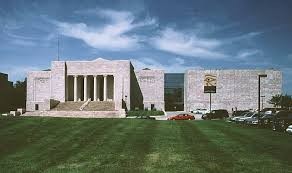Joslyn Art Museum
Introduction
Text-to-speech Audio
The Joslyn Art Museum is the leading fine arts museum in Nebraska. It was opened in 1931 at the initiative of Sarah H. Joslyn in memory of her husband, businessman George A. Joslyn
Images
The extraordinary Art Deco building was hailed not only as an important addition to the city of Omaha, but to modern American architecture as well. In 1938 it was listed among the 100 finest buildings in the United States.

Backstory and Context
Text-to-speech Audio
New Englanders George and Sarah Joslyn came to Omaha in 1880. Married in 1874, the couple first moved to Montreal and later to Des Moines, Iowa, where George took a job unloading freight cars for the Iowa Paper Company. The company’s main business was providing small-town Iowa newspapers with “ready-print,” a news sheet pre-printed with special features and advertisements, which was then printed on the outside with local news. George Joslyn quickly attained an office position in the firm, and when a branch office opened in Omaha, he was offered the position of manager. The expanded company was reorganized in 1881 as the Western Newspaper Union.
By 1890, Joslyn had acquired controlling interest in the company’s stock and began a vigorous expansion campaign. At the time of his death, the Western Newspaper Union, with George Joslyn as its president and general manager, was nationally recognized as the largest newspaper service organization in the world. It operated printing plants and publication offices in 32 prominent cities, six exclusive plate foundries, the largest publication plant in the city of Chicago, 17 wholesale paper houses, and pulp and paper mills in northern Wisconsin. George Joslyn was the richest man in Nebraska.
When associates suggested he move his business headquarters East, George answered that his money had been “made in Omaha and it would be spent in Omaha.” The Joslyns loved their adopted city and actively supported community projects, toward which it is estimated they gave more than $7 million. They gave generously to the University of Omaha, and among their many charities were the Humane Society, the Old People’s Home, and the Child Saving Institute. They often opened their home, Lynhurst (dubbed “Joslyn Castle” by Omahans because of its grand, baronial style), to parties of underprivileged and orphaned children. Their only child died in infancy, so they raised a foster daughter, Violet, as their own.
After her husband’s death, Mrs. Joslyn devoted herself to creating a memorial that would perpetuate their shared interests in music and art, as well as benefit the greatest number of people possible. She decided to build a concert hall surrounded with art galleries. When it opened on November 29, 1931, the new museum received several private collections as gifts, as well as collections from the Art Institute of Omaha and the Friends of Art.
When associates suggested he move his business headquarters East, George answered that his money had been “made in Omaha and it would be spent in Omaha.” The Joslyns loved their adopted city and actively supported community projects, toward which it is estimated they gave more than $7 million. They gave generously to the University of Omaha, and among their many charities were the Humane Society, the Old People’s Home, and the Child Saving Institute. They often opened their home, Lynhurst (dubbed “Joslyn Castle” by Omahans because of its grand, baronial style), to parties of underprivileged and orphaned children. Their only child died in infancy, so they raised a foster daughter, Violet, as their own.
After her husband’s death, Mrs. Joslyn devoted herself to creating a memorial that would perpetuate their shared interests in music and art, as well as benefit the greatest number of people possible. She decided to build a concert hall surrounded with art galleries. When it opened on November 29, 1931, the new museum received several private collections as gifts, as well as collections from the Art Institute of Omaha and the Friends of Art.
Sources
http://www.joslyn.org/about/history/
